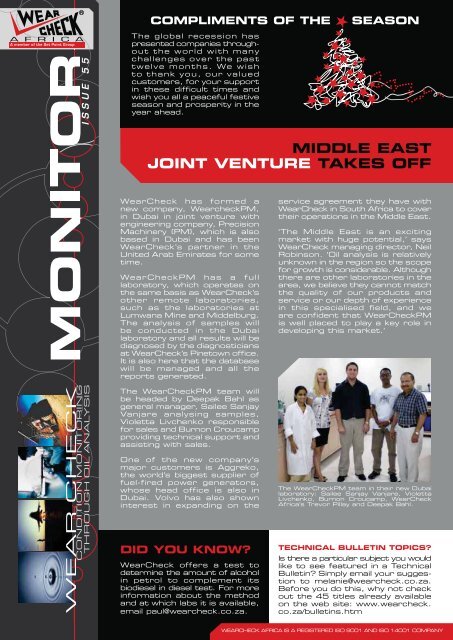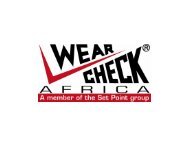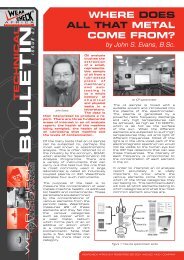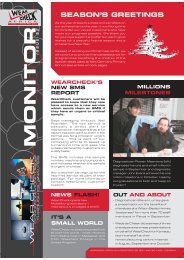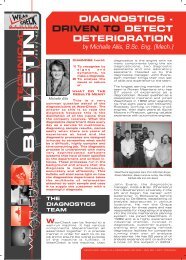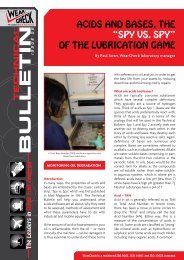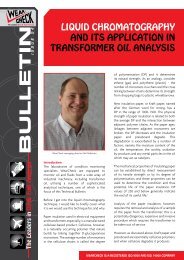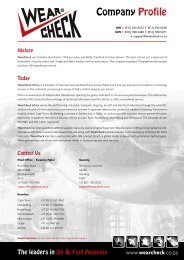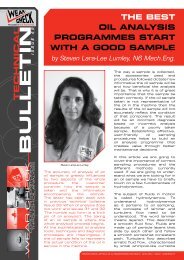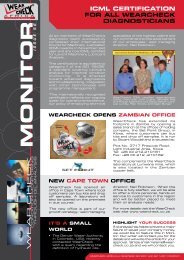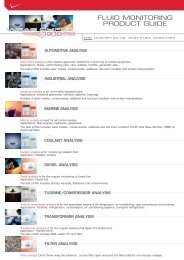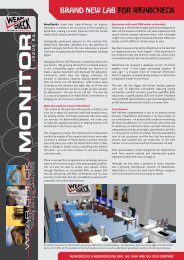Monitor Issue 55 - WearCheck
Monitor Issue 55 - WearCheck
Monitor Issue 55 - WearCheck
You also want an ePaper? Increase the reach of your titles
YUMPU automatically turns print PDFs into web optimized ePapers that Google loves.
COMPLIMENTS OF THESEASONISSUE <strong>55</strong>The global recession haspresented companies throughoutthe world with manychallenges over the pasttwelve months. We wishto thank you, our valuedcustomers, for your supportin these difficult times andwish you all a peaceful festiveseason and prosperity in theyear ahead.MIDDLE EASTJOINT VENTURE TAKES OFF<strong>WearCheck</strong> has formed anew company, WearcheckPM,in Dubai in joint venture withengineering company, PrecisionMachinery (PM), which is alsobased in Dubai and has been<strong>WearCheck</strong>’s partner in theUnited Arab Emirates for sometime.<strong>WearCheck</strong>PM has a fulllaboratory, which operates onthe same basis as <strong>WearCheck</strong>’sother remote laboratories,such as the laboratories atLumwana Mine and Middelburg.The analysis of samples willbe conducted in the Dubailaboratory and all results will bediagnosed by the diagnosticiansat <strong>WearCheck</strong>’s Pinetown office.It is also here that the databasewill be managed and all thereports generated.service agreement they have with<strong>WearCheck</strong> in South Africa to covertheir operations in the Middle East.‘The Middle East is an excitingmarket with huge potential,’ says<strong>WearCheck</strong> managing director, NeilRobinson. ‘Oil analysis is relativelyunknown in the region so the scopefor growth is considerable. Althoughthere are other laboratories in thearea, we believe they cannot matchthe quality of our products andservice or our depth of experiencein this specialised field, and weare confident that <strong>WearCheck</strong>PMis well placed to play a key role indeveloping this market.’The <strong>WearCheck</strong>PM team willbe headed by Deepak Bahl asgeneral manager, Sailee SanjayVanjare analysing samples,Violetta Livchenko responsiblefor sales and Burnon Croucampproviding technical support andassisting with sales.One of the new company’smajor customers is Aggreko,the world’s biggest supplier offuel-fired power generators,whose head office is also inDubai. Volvo has also showninterest in expanding on theThe <strong>WearCheck</strong>PM team in their new Dubailaboratory: Sailee Sanjay Vanjare, ViolettaLivchenko, Burnon Croucamp, <strong>WearCheck</strong>Africa’s Trevor Pillay and Deepak Bahl.DID YOU KNOW?<strong>WearCheck</strong> offers a test todetermine the amount of alcoholin petrol to complement itsbiodiesel in diesel test. For moreinformation about the methodand at which labs it is available,email paul@wearcheck.co.za.TECHNICAL BULLETIN TOPICS?Is there a particular subject you wouldlike to see featured in a TechnicalBulletin? Simply email your suggestionto melanie@wearcheck.co.za.Before you do this, why not checkout the 45 titles already availableon the web site: www.wearcheck.co.za/bulletins.htmWEARCHECK AFRICA IS A REGISTERED ISO 9001 AND ISO 14001 COMPANY
IT’S A SMALL WORLD<strong>WearCheck</strong> receives compliments about itstechnical publications and queries about oilanalysis and the company’s training coursesfrom all over the world on a regular basis.The most recent were sent by:• A laboratory technician working in a usedengine oil analysis lab in Harare, Zimbabweand studying towards his Bachelor ofChemistry degree.• A lubes technical engineer at PetronasMarketing Sudan Ltd in Khartoum, a sistercompany of Engen Petroleum Sudan.• An engineer from ANCAP in Montevideo,Uruguay's state-owned petroleum company.• An engineering supervisor working forEthiopian Airlines at their headquartersat Bole International Airport.• A commercial manager for Horizon Agencies& Commercial Services, a leading serviceprovider for the energy sector in Yemen.• A veteran oil researcher at the IndustrialTechnology Center of Southwestern IllinoisCollege in Granite City in the USA.• A mechanic on an oil rig in the Libyan desert.This bears testimony to <strong>WearCheck</strong> Africa’sstatus as a globally respected company inthe field of oil and fuel analysis.MEET THE MIDDELBURG LAB TEAMThe Middelburg lab is going from strength to strength. Anew ICP instrument was recently installed and the lab isnow fully integrated with the Pinetown laboratory. Makingup the team are (from left) Chris Hattingh (technicalsales and support consultant), Annelien Rietvelt (officeadministrator), Dudu Mbatha (lab assistant), Leanne vanNiekerk (lab assistant with experience of thermography,oil and vibration analysis), Julia Motshwene (housekeeper)and Jaco Stapelberg (thermographer and technical fieldsupport consultant). Customers in the area can delivertheir samples to this lab and may also phone to ask for acollection from their offices. <strong>WearCheck</strong> Middelburg canbe contacted on (013) 246-2966.PRODUCT PICK<strong>WearCheck</strong> offers a number of convenientaccessories to help customers take cleanand representative samples quickly andeffectively. Here is a selection of some ofthe products available.SAMPLING GUNThis sample extractionpump (including rinsebottle) is used to takeoil samples from alltypes of equipment.Available with ¼”,3/16” or 8mm tubing.Product code: WISPHIGH PRESSUREVALVEThis sampling valveconnector is used todraw the oil from highpressure systems. Ithas a 12mm thread.Product code: WMMGEARBOX SAMPLINGVALVE CONNECTORFor use with the gearboxsampling valve fortaking samples fromindustrial gearboxes andpressurised systems.Product code: WVCGFILTER CUTTERRobust and custommadefor <strong>WearCheck</strong>to remove the paperelement from a spin-onfilter with minimal effort.Product code: WFCSAMPLE TUBINGAND CONNECTORThe hard nylon tubingis sold in 1 metrelengths; the connectoris used with the enginesampling valves (Metricor Imperial) for takingoil samples from engines and low pressuresystems.Product codes for tubing: WSTN1/4(1/4" OD), WSTN3/16 (3/16" OD),WSTN8 (8mm OD)Product code for connector: WVCE“BORDERLINE” CHANGES TO “CAUTION”The terminology for the sample severitystatus “borderline” will shortly be changingto “caution” on <strong>WearCheck</strong> reports.‘There are currently four terms to describethe severity of samples – 0 (normal), 1(borderline), 2 (urgent) and 3 (critical),’ saysmanaging director, Neil Robinson. ‘We havedecided to change “borderline” becauseit was occasionally misinterpreted by ourcustomers.’‘On the one hand, some customers felt that“borderline” indicated a situation of imminentfailure, causing them to take drastic action,2whereas <strong>WearCheck</strong> intended this to indicatea situation where a component might nolonger be normal and some minor interventionmay be required. On the other hand, somecustomers ignored the term “borderline”,whilst <strong>WearCheck</strong>’s intention was that someaction should be taken and that, although itwas not urgent, the component should bemonitored closely. It was felt that “caution”was a better way of expressing this.’A full explanation of this can be viewed on the<strong>WearCheck</strong> web site: http://www.wearcheck.co.za/Bulletin%20Board.htm
MAKING HEADWAYWELCOME BACK, ASHLEYA warm <strong>WearCheck</strong> welcome to AshleyMayer, formerly a diagnostician in thePinetown office, who has rejoined thecompany after six years in the USA.Ashley joined <strong>WearCheck</strong> as adiagnostician in 1996 after completinghis BSc in mechanical engineering atthe University of Natal. He then workedas a tribologist for ABB South Africafor almost three years before movingto the USA in November 2003, wherehe was employed by Noria Corporation.Noria, which has its headquarters in Tulsa,Oklahoma, is well known internationallyfor serving the lubrication industry bygathering and disseminating knowledgethrough training, magazine publications,conferences and consulting. Ashleystarted off as a technical consultant,becoming a senior technical consultantand later director of applicationsengineering. Based at his home office inPhiladelphia, Pennsylvania, his work tookhim all around the United States, Canadaand the Caribbean, working in factoriesand mines in many different industries.His focus was improving lubrication-relatedactivities at the plants, including oil analysis.Ashley presented many training courses forNoria and authored the column "SqueakyWheel" for both the Practising Oil Analysisand Machinery Lubrication magazines. Heis a Level II certifiedMachinery LubricantAnalyst (MLA), a LevelI Machinery LubricationTechnician (MLT) with theInternational Council forMachinery Lubrication(ICML), and a CertifiedMaintenance andReliability Professional(CMRP) with the Societyfor Maintenance andReliability Professionals(SMRP).Ashley Mayer Whilst still in SouthAfrica, Ashley completedthe Advanced Business Programme at theTechnikon Natal in 1999 and his NationalCertificate in Datametrics at the Universityof South Africa in 2006.In his current position as senior technicalconsultant in <strong>WearCheck</strong>’s Johannesburgoffice, Ashley will be visiting customers andhelping with technical problems. He will alsobe responsible for developing <strong>WearCheck</strong>’straining courses and the company’sindustrial training programme.‘I’m really excited to be back home again,’ hesaid. ‘You don’t know how much you missit until you’re back. I’m looking forward torebuilding old relationships and making newones. In the near future, we’ll be rollingout some new products in the training,consulting and accessories markets, sowatch this space!’NEW ANALYTICAL CHEMIST FOR SPECIALITY LABChemist, Mark Govender in<strong>WearCheck</strong>’s Isando specialitylaboratory.Mark Govenderhas joined Wear-Check’s specialitylaboratory inIsando as chemist.His job is to ensurethe smoothrunning of the fueland transformeranalysis functionsin the lab, includingquality assurance.He is also closely involved with thedevelopment of new tests and <strong>WearCheck</strong>’sprogramme to attain ISO 17025 statusfor certain aspects of transformer analysisby mid next year.Mark attained his Masters of Sciencedegree in pure and applied chemistry at theUniversity of Natal (Durban). He is a memberof the SA Chemical Institute (SACI) and ismidway through a B Tech degree in qualitymanagement through UNISA.He comes to <strong>WearCheck</strong> from the CSIRwhere he worked for three years, first as alaboratory analyst and later as a researcher intheir forestry and forestry products division.Here he was responsible for developing rapid,beneficial and internationally competitiveanalytical methods for this industry inSouth Africa. He also supervised theirlaboratories and ensured that all safety,health, environment and quality (SHEQ)requirements were met.Whilst at the CSIR, he participated in aresearch and innovation core skills programmeand attended a one-month course organisedwith the International Atomic Energy Agency(IAEA) on how to identify organic contaminantsthrough water and soil analysis. He alsovisited Austria in 2008 to develop analyticalskills that would be beneficial to the pulpingindustry in South Africa.Mark has a thorough working knowledgeof a variety of instruments and analyticaltechniques including size exclusion multi anglelaser light scattering (SEC-MALLS), gas andliquid chromatography, mass and infraredspectroscopy and UV spectrophotometry.He is thoroughly enjoying the dynamic workingenvironment that the speciality lab offersand being part of a team that is dedicatedto ensuring that <strong>WearCheck</strong> remains aforerunner in oil and fuel analysis globally.3
OPERATION GORILLATaking infrared images of a gorilla is all in aday’s work for <strong>WearCheck</strong>’s thermographyteam. Well actually, this is the first time theyhave received such an unusual request butwhen the Johannesburg Zoo asked for helpin determining what could be ailing their offcolourgorilla, Makokou, they were quick torespond.The brief was to undertake an infraredinspection of Makokou, a male gorilla, todetect any physical anomalies that couldexplain his poor health.‘We use an infrared camera that allows theoperator to see in the infrared wavelength,not in the visible, as humans see, applyingthe principle of first service radiation,’ said<strong>WearCheck</strong> thermographer Jaco Stapelberg.‘Because this is not an x-ray, the cameracannot see through an object but thethermal energy emitted from a body istransformed into a visible image that we cansee. Thus, what lies beneath the surface canbe portrayed as a problem or anomaly suchas inflammation, blocked veins close to theskin or poor blood circulation.’not get too close to and which could notbe positioned exactly as we wanted,’ Jacoexplained. ‘We took a number of infraredimages of Makokou but not all positionscould be inspected.’‘When dealing with a warm blooded body, weidentify abnormalities by comparing one side ofthe body with the other. Any differences couldindicate a problem. In Makokou’s case, theinfrared patterns on the images we took werevery symmetrical, indicating that he appearedto be in a healthy condition. However, ifthere were any "hot spots" underneath thefur, it would have been extremely difficult todetect them and compare them with any lowtemperature areas and so some problemsmight have been overseen.’‘Thermal imaging, although very effective insome applications, does have its limitationsthough, particularly when dealing with a mobilegorilla with a thick coat of fur that we couldNEW TRANSFORMER ANALYSIS COURSEMore than 30 people signed upfor <strong>WearCheck</strong>’s new transformeranalysis course. Amongst them wereJuan Pieterse from ABB’s MatimbaSite (left), seen here in discussionwith Gert Nel of <strong>WearCheck</strong>.<strong>WearCheck</strong>presented anew one-daycourse ontransformeranalysis at itsJohannesburgoffices inNovember.It w a sattended by35 people –mainly customersandassociatesfrom JohannesburgandDurban whoare involvedwith maintaining transformers or are workingin this field and wanted to broaden theirknowledge of the subject. Some of thecompanies represented included ABB,ASA Metals, JAS Engineering and MicosaIndustries.Said Mark Govender, chemist in<strong>WearCheck</strong>’s speciality laboratory, ‘Thecourse was designed to fill a gap in theknowledge of the various tests done ontransformers, especially the combination oftests as it is long past the time for M/A/Dtesting to be sufficient for transformers.Our aim was to give a detailed explanationof the different laboratory tests which areavailable and their benefits.’The course was presented by Mark along withGert Nel, speciality laboratory diagnostician,Werner Buys, who undertakes on sitesampling and field support for <strong>WearCheck</strong>,and Jaco Stapelberg, thermographer andtechnical field support consultant based inthe Middelburg laboratory. It covered:• Correct sampling procedures• The different test methods and standardsused by <strong>WearCheck</strong>, including:- Furanics- DGA- M/A/D- PCB- Tan Delta• An explanation of <strong>WearCheck</strong> reports• A tour of the speciality laboratory‘The course was well received by the delegateswho said that they were impressed with thecontent and the knowledge of the presenters.’Mark said. ‘Many requested dates for futurecourses as they believe others in theirorganisation would benefit from it.’<strong>WearCheck</strong> plans to run four courseson transformer analysis next year, whichwould be of value to anyone who workswith transformers, transformer owners,maintenance managers and engineers. Formore information, phone Michelle van Dykon (011) 392-6322.
LUBE TIP by Jim Fitch of Noria CorporationTHESE ADDITIVES DON’T EXISTI’m afraid I have some bad news . . . andno, it’s not about the economy. It’s aboutwhat I often call “imaginary additives”. Theseare the additives that seem to exist in theminds of many lubrication practitioners butdon’t exist in the physical world of lubricationreality. They seem to provide solace to thosewho pay the bills of machinery unreliability.As good as modern lubricants may be, theyare never a panacea for bad lubricationpractices. Conversely, real additives canbe real problem-solvers that enhance theperformance and reliability of both themachine and the lubricant. So, there’s adifference between the real and imaginary. Iwant you to know the difference. This columnwill go down the list of imaginary additivesand discuss the many misconceptions thatpervade the lubrication community. I hate tobe a myth-buster, but reality is reality, solet’s get started:ANTI-DIRTThe only remedy for dirty oil is a filter or anoil change. Even better is not having dirtyoil in the first place (via routine contaminantexclusion). Don’t imagine that there issome virulent, dirt-curing additive in yourlubricant’s formulation. Dirt doesn’t carehow sophisticated your lubricant’s chemistrymight be. Whether your lubricant emergedfrom a backroom or a space-age laboratory,dirt will spare no effort to cut, abrade, dentand score your machine surfaces.WRONG-OIL FORGIVERLubricants and their additives do notautomatically adjust to the environs andneeds of the machines within which they areplaced. There are thousands of differentlubricant formulations on the market for areason. They are not alike and they don’tperform alike and, hence, users will notreceive like results. Precision lubrication isabout precisely selecting the right lubricantfor the target machine and making sure thatparticular lubricant is always used and thenreplaced before its life is done.WATER ZAPPERWater exacts an evil curse on lubricants andmachines. It accelerates wear, corrosion,microbial growth, friction, additive depletion,aeration, varnish, oxidation . . . and, well, thelist goes on and on. Outside of the limitedcapability of rust inhibitors, additives don’tstop the penetration and damage exertedby water. Only controlling the invasion anddispersion of water in our lubricants solvesthese problems.OIL STARVATION PAIN-KILLERDespite the assertions of some late-nighttelevision infomercials, additives are nota solution for starved oil supply or low oillevels. Lubricants service many functionsbeyond simply controlling friction and wear.As such, they need to be present as anentire formulation, not simply a few chemicalremnants clinging to the frictional surfacesof our machine.VARNISH AND SLUDGE PACIFIERVarnish and sludge are produced via many oildegradation pathways. Once they get infusedinto the oil and deposit on machine surfaces,there is no easy solution to eradicate theirpresence short of an oil change and flush.Additives may help slow the formation ofvarnish and sludge precursors, but they willdo little to pacify damage after they form.GLYCOL NEUTRALISEREthylene glycol is mixed with water and used asa coolant in a wide range of machines. Whenallowed to invade a lubricant, it becomes apungent contaminant that can wreak havoc innumerous ways. Sadly, the thought that thereare lubricant additives that will neutralize theeffects of glycol contamination is nothingbut a fantasy. As much as 10 percent of alldiesel engine lubricants in service have traceamounts of glycol contamination. Many arefar more grossly contaminated.SOOT TERMINATORSoot can be dispersed by additives, but itcan’t be easily expunged. Even dispersedsoot causes wear when oil films becomecontracted, such as in cam lobe/followercontacts and at the ring reversal area oncylinder walls in diesel engines. Soot canalso mop up important polar additives andprematurely remove them from active duty.OVER-GREASING ELIXIROne of the most common root causes ofrolling-element bearing failure is over-greasing.This practice damages seals and shields, andcauses uncontrolled heat excursions thataccelerate wear and lubricant degradation.No additive has the capacity to work as amagic elixir under such distressful conditions.CONCLUSIONReliability emerges from the optimumcombination of quality lubricants and bestpracticelubrication. Don’t spend more moneyon premium lubricants hoping you can spendless on lubrication. This is a false economy.There is no substitute for vigilant inspection,frequent and thorough oil analysis, andwell-deployed (and engineered) lubricationpractices.No question, today’s additive technology canserve as a solution-provider across a widerange of potential problems that frequentlyplague machinery. Yet, they are unable to bemiracle cures for numerous other maladies.Practitioners need an arsenal of tools andskills to get the desired reliability results.Begin with training and then follow withprogrammatic structure and procedures.Develop a culture of lubrication excellence.And remember, reliability is everyone’sresponsibility.This article appeared in the January/February2009 issue of Machinery Lubrication5
MICHELLE JOINSTHE MILLIONAIRE’S CLUB<strong>WearCheck</strong> hasa new memberof its Millionaire’sClub – seniordiagnosticianMichelle Allis (right)diagnosed hermillionth sampleon Friday 25September. Shejoins diagnosticsmanager JohnEvans (seated,centre) and fellowdiagnosticianRowan Maartensas the thirdmember of thisprestigious group.OUT AND ABOUT<strong>WearCheck</strong>’s quality administrator, MelanieHynd was invited to make a presentationto SAIT in Johannesburg in October on theimplementation of ISO14000.HIGHLIGHT YOUR SUCCESSIf oil analysis has helped prevent a major failure orsaved your company money, we would like tofeature this in <strong>Monitor</strong>. Our writer will contact youfor the details and will write the article for yourapproval. Simply email melanie@wearcheck.co.zaand we will contact you.SOMETHING ON YOUR MIND?If you have feedback of any sort you’d like togive us – praise, problems or suggestions -there is no need to wait for a customer survey.Feel free to email us at any time on support@wearcheck.co.za. Or complete the surveyonline on the web site: http://online.wearcheck.co.za/PRODUCTION/anon/survey.aspx2010 TRAINING COURSESCOURSESJOHANNESBURG PINETOWN MIDDELBURGNetCheck: Software package 8 Feb 7 Jun 11 Oct 16 Aug 8 Mar 6 SeptOil Analysis One:Understanding oil and its analysis 9-10 Feb 8-9 Jun 12-13 Oct 17-18 Aug 9-10 Mar 7-8 SeptOil Analysis Two:Report interpretation 11 Feb 10 Jun 14 Oct 19 Aug 11 Mar 9 SeptOil Analysis Three: Management 12 Feb 11 Jun 15 Oct 20 Aug 12 Mar 10 SeptOil Analysis One covers two full days and costs R3 400 plus VAT. Oil Analysis Two and theNetCheck course cover one full day each and each costs R1 700 plus VAT. Oil AnalysisThree is a half day course and costs R600 plus VAT. More details on the content of eachcourse can be viewed under Training on the <strong>WearCheck</strong> web site: www.wearcheck.co.za.For all bookings phone Michelle van Dyk on (011) 392-6322.TRAINING NEAR YOUIf you would like <strong>WearCheck</strong> to arrange training courses in any of the following places, pleasephone Michelle van Dyk in the Johannesburg office or email training@wearcheck.co.za:Bloemfontein Cape Town Kimberley Makopane MiddelburgNelspruit Port Elizabeth Rustenburg SteelpoortBotswana Namibia Tanzania (Mwanza) Zambia (Kitwe)If you would prefer to receive future issues of <strong>WearCheck</strong> <strong>Monitor</strong> and Technical Bulletinvia e-mail in pdf format instead of in printed form, please e-mail a request to: support@wearcheck.co.zaTHE LEADER IN OIL AND FUEL ANALYSISKWAZULU-NATAL9 LE MANS PLACEWESTMEAD, PINETOWN, RSAPO BOX 15108, WESTMEAD 3608TEL: +27 31 700 5460FAX: +27 31 700 5471support@wearcheck.co.zawww.wearcheck.co.zaGAUTENG25 SAN CROY OFFICE PARKDIE AGORA RD, CROYDON RSAPO BOX 284, ISANDO 1600TEL: +27 11 392 6322FAX: +27 11 392 6340support@wearcheck.co.zawww.wearcheck.co.zaPublications are welcome to reproduce articles or extracts from them providing they acknowledge <strong>WearCheck</strong> Africa, a member of the Set Point Group.Felicity Howden Public Relations 12/09


